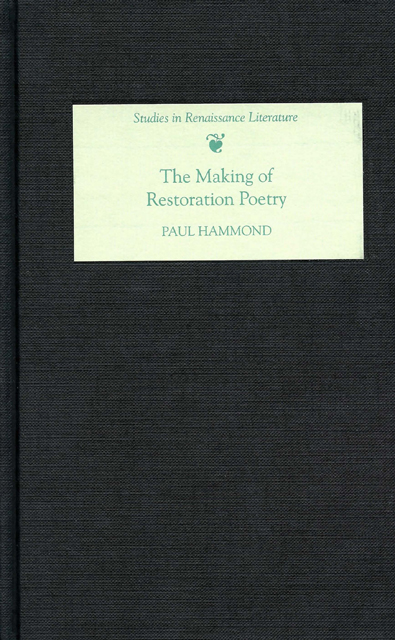3 - Anonymity in Restoration Poetry
Published online by Cambridge University Press: 18 March 2023
Summary
IN 1963 David M. Vieth published his magisterial book Attribution in Restoration Poetry, in which he investigated the tangled web of attribution, misattribution, and anonymity in the works associated with the Earl of Rochester. Vieth saw anonymity and dubious attribution as problems to be solved, and his aim was to establish as far as possible the answer to the question, ‘What did Rochester actually write?’, and to the secondary question, ‘Who then actually wrote the poems which were wrongly attributed to Rochester?’ These are important questions, and Vieth's book laid secure foundations for the scholarship and criticism of Restoration poetry in subsequent years by providing the most judicious account of the boundaries of the Rochester canon. But there are other ways of understanding the uses of anonymity in the Restoration period: instead of regarding anonymity as a problem, can we not see it as a functional device, as a resource which enabled certain kinds of writing and reading, rather than a tiresome puzzle which obscures the real canon of those named poets in whom we are primarily interested?
The influence of modern editions of Restoration works is so powerful that it often takes a special effort both of scholarship and of imagination to undo the neat packages into which editors have assembled the poetry of Rochester or Dryden or Etherege, and instead to envisage that poetry as it was encountered by its first readers: circulating in the form of separate printed pamphlets or in manuscript, often anonymously or with conjectural attributions. Editors who carefully assemble a canon under the name of a major poet do something which was not only rarely attempted in the period, but which may actually run counter to Restoration habits of reading and assumptions about authorship and the function of poetry. Many writers did not show that concern for the creation of a personal œuvre under their own name which modern editors and critics display on their behalf. Marvell's canon was assembled after his death, and was shaped at least partly by the political concerns of his editor and publisher. Rochester allowed his poems to circulate separately, and for the most part anonymously, in manuscript, and it was not until 1691, eleven years after his death, that a collection of his poems appeared which was free from spurious attributions (though it was not free from bowdlerizations).
- Type
- Chapter
- Information
- The Making of Restoration Poetry , pp. 49 - 72Publisher: Boydell & BrewerPrint publication year: 2006

